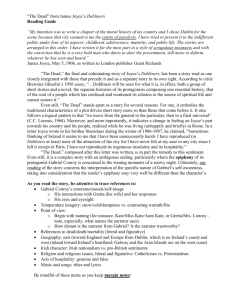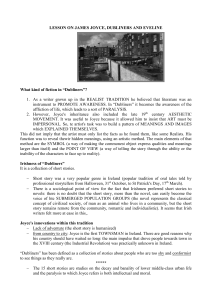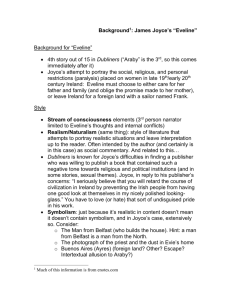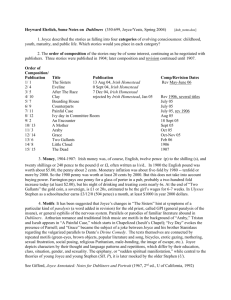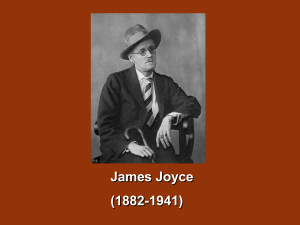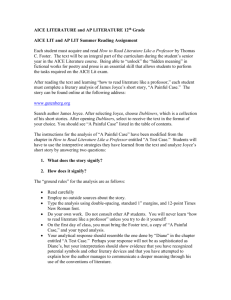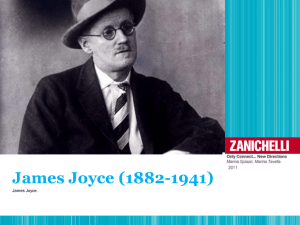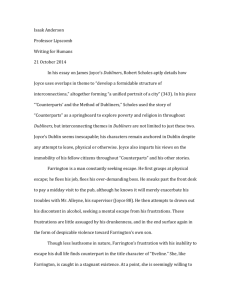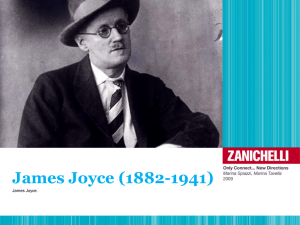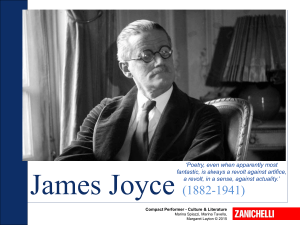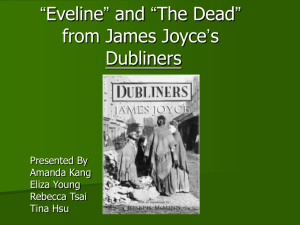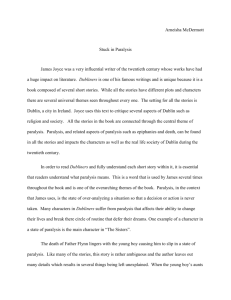Dubliners
advertisement
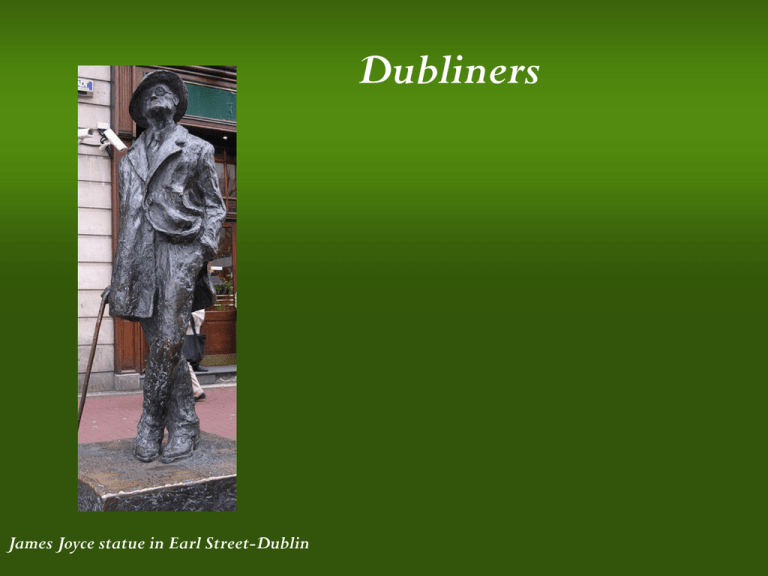
Dubliners James Joyce statue in Earl Street-Dublin A collection of 14 +1 short stories adolescence childhood The sisters An encounter Araby Mature life Public life Eveline A little cloud Grace Two gallants Clay Ivy day in the committee room After the race Counterparts The boarding house A painful case The dead A mother Joyce’s purpose “My intention was to write a chapter of the moral history of my country and I chose Dublin for the scene because that city seemed to me the centre of paralysis. I have tried to present it to the indifferent public under four of its aspects: childhood, adolescence, maturity, and public life. The stories are arranged in this order. I have written it for the most part in a style of scrupulous meanness and with the conviction that he is a very bold man who dares to alter in the presentment, still more to deform, whatever he has seen and heard.” James Joyce A paradox He abandoned his native land , culture and religion For the rest of his life he wrote about nothing else The struggle for publication Written in 1905 Too many allusions, places, people who would be recognized Published in 1914 Language and material considered too free Objections about the irreverent treatment of EdwardVII in “Ivy day” It was finally published only when Joyce was enjoying some renown after the “Portrait”. When the book came out no one was particularly shocked Short story Features Brevity 70-80 pages Few paragraphs compression Single central theme immediacy It strikes the reader with immediate images consistency Unity of time –place-action economy Language is concise. homogeneity Despite the simplifications, it is a complete unified whole Limited number of characters Why short stories? European tradition Maupassant Chekhov Gaelic tradition Wilde Particularly suited to give expression to submerged groups Great call for short stories in many magazines and newspapers Features Each of the fifteen stories in James Joyce’s Dubliners presents a flat portrait. Each story in the collection is centred in an epiphany, and each story is concerned with some failure or deception, which results in realization and disillusionment. Man-woman relationship epiphany Religion Themes Autobiography Decay Irish politics Death Result Paralysis Escape Corruption A grim picture of his homeland and its inhabitants Style Realism and symbolism Symbolic colours Characters are described through introspection rather than description Subjective perception of time Omniscient narrator and single point of view disappear. Media res Characters vividly painted Total objectivity of the artist Artist “invisible” in his works Independent from all moral, religious, political pressures Isolated from society in order to be objective and give a true image of it. He chose to be an exile for this purpose Epiphany In the Christian tradition the Feast of the Epiphany celebrates the revelation of Christ's divinity to the Magi Joyce adopts it to signify a sudden revelation in the everyday life of the characters, The moment in a novel or a story when a spiritual awakening is experienced, in which all the details, thoughts, gestures, objects, feelings come together to produce a new sudden awareness Thank you Joyce was aiming at a “style of scrupulous meanness” which implied his rejection of a complicated plot, a ruthless cutting of all superfluous details, and rigorous selection, all objectives which his keen sense of artistic form allowed him to attain. The colours he uses to suggest the pervading atmosphere of paralysis and decay are essentially brown and yellow, sometimes green. Joyce often pays particular attention to the colour of his characters’ eyes as indicator of their personality. They use linguistic registers that closely reflect their social situation and psychological state His self-imposed exile was necessary not only to give him the unrestricted artistic climate he needed, but also to give him the objectivity he needed to write about Ireland with the necessary emotional and intellectual detachment. Deaths are also implied in some stories, as in The sisters and in "Araby" — those of the boys' parents, absent from both tales. Thereafter, death follows death in Dubliners: Dead is the priest who last lived in the house in "Araby"; Eveline's mother in "Eveline"; and Michael Furey and the other inhabitants of the churchyard in which he lays buried in "The Dead." Those are only the actual deaths in the book; add spiritual and moral deaths, and Dubliners grows as crowded with corpses as the Hades episode in Homer's Odyssey. The author’s task was not to tell people what to believe but to persuade them to perceive reality differently. For this reason Joyce thought a work of art should be impersonal. In Dubliners he remains essentially outside the tales since he does not give himself an authorial voice that intervene in the narration. He blamed the sorry state of affairs on outside forces — England and the church — rather than the Irish themselves. Looking back, the writer himself found the book insufficiently sympathetic to Dubliners' best qualities (hospitality, for example). He would repair this deficiency in his masterpiece, Ulysses, which itself began as an aborted Dubliners story. According to the critic O’ Connor, the novel adhere to the classic concept of civilized society, like supported by the novels of Jane Austen. The short novel on the other hand, remains distant from the community. Joyce wanted to write a people whose cultural and linguistical identity had been repressed by the English. Paralysis or stagnation is a characteristic condition of modern man which affects many of us and may have different sources: the frustration of an unfulfilling job, an unhappy marriage or lack of friendship; a life that many don’t like but which few are able to change. In most of the stories the protagonists have some desire they would like to fulfill; they attempt to do so but are forced to give up and accept the limitations imposed by the social context they have to live in. The style of Dubliners is complex. Apparently it is realistic, it recreates characters, places, streets, pubs, idioms of contemporary Dublin. On the other hand it is also symbolic because it gives the common object unpredicted depth and becomes the key to a new, more conscious view of reality. In the past, fiction writers had almost invariably changed the names of their short-story and novel settings, or discretely left them out altogether. In fact, including these details delayed publication of the book by years, as potential publishers and printers feared lawsuits by those businesses mentioned by name It was published on the newspaper “ The Irish Homestead” with the pseudonym Stephen Dedalus In Ireland the short story is a national tradition, with roots in the Gaelic culture. Every year from Halloween to St. Patrick day story tellers were the very soul of the “ceili”, a gathering of people around the fire place. Before discos and nightclubs, there were céilidhs in most town and village halls on Friday or Saturday nights; they are still common today. In more recent decades, the dancing portion of the event has usurped the older meanings of the term. Paralysis Physical Moral External forces Climax of the stories Politics, religion and culture not paralysis but its revelation In a letter to his brother Stanislaus he wrote: “What’s the matter with you is that you are afraid to live.You and people like you.The city is suffering of hemiplegia of the will.” Decay Paralysis leads to decay things that don’t move begin to erode quickly Again, this idea is applied not only to the individuals, but also to Ireland in general. Escape Opposite to paralysis Caused by a sense of enclosure Doomed to failure Religion A negative and oppressive force Paralleled to the negative authority of the English rule. Dubliners is filled with details of Church institutions Sacred practices and traditions Church buildings Repeated references to the catechism Religious attitudes Irish politics Joyce did not take an active part in politics He did not approve the Irish Ireland movement or the Irish literary revival They are not a solution but He was not supporter of British rule in Ireland Man-woman relationship He showed suffering women Socially and legally inferior to men Death Dubliners begins with a death and ends with a story called “The Dead” Death is the natural end of the previous ideas: paralysis leads to decay which ultimately ends in death Especially in “The Dead,” we will witness a number of characters that live and breathe, but are actually “dead” inside The collection overflows with unattractive human behaviour: simony, absenteeism, pederasty, drunkenness (all of them in the first three stories alone!), child and spousal abuse, gambling, prostitution, petty thievery, blackmail, and suicide. Even the use of the mild British oath "bloody," was thought by many to go beyond the bounds of good taste. A precedent existed in the 19th century French Naturalism, but no writer had ever been quite as explicit as Joyce in Dubliners. At the beginning of the 20th century radical changes were taking place in the way man saw the world. Ideas concerning consciousness, time and space were reformulated by major figures like Bergson, Nietzsche, Freud and Einstein. In the fields of science and philosophy the idea of a single truth was called into question and consequently writers , too, found a single voice or point of view inacceptable.
